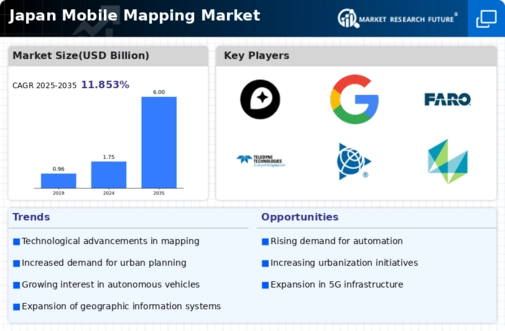Rising Urbanization
The rapid urbanization in Japan is a pivotal driver for the mobile mapping market. As cities expand, the need for accurate mapping and navigation solutions becomes increasingly critical. Urban areas are experiencing a surge in population density, leading to complex infrastructure requirements. This complexity necessitates advanced mobile mapping technologies to facilitate urban planning, traffic management, and public safety. The mobile mapping market is likely to benefit from this trend, as municipalities and private enterprises seek to leverage geospatial data for efficient resource allocation. Furthermore, the urbanization rate in Japan is projected to reach approximately 91% by 2030, indicating a growing demand for innovative mapping solutions to support urban development initiatives.
Demand for Smart City Solutions
The push towards smart city initiatives in Japan is significantly influencing the mobile mapping market. As urban centers strive to enhance livability and sustainability, the demand for integrated mapping solutions that support smart infrastructure is on the rise. Mobile mapping technologies play a crucial role in the development of smart transportation systems, energy management, and public safety applications. The mobile mapping market is expected to see substantial growth as municipalities invest in these technologies to create more efficient urban environments. Reports indicate that the smart city market in Japan could reach a valuation of $1 trillion by 2030, further underscoring the potential for mobile mapping solutions to contribute to these ambitious projects.
Increased Investment in Infrastructure
Japan's ongoing investment in infrastructure development is a significant driver for the mobile mapping market. The government has allocated substantial budgets for transportation, utilities, and public works projects, necessitating precise mapping solutions for effective planning and execution. The mobile mapping market is poised to benefit from these investments, as accurate geospatial data is essential for minimizing costs and ensuring project timelines are met. Recent government reports indicate that infrastructure spending in Japan is projected to exceed ¥100 trillion by 2025, highlighting the critical role of mobile mapping technologies in supporting these large-scale initiatives. This trend suggests a robust demand for mobile mapping services in the coming years.
Integration of AI and Machine Learning
The integration of artificial intelligence (AI) and machine learning technologies into the mobile mapping market is transforming the landscape of geospatial data collection and analysis. These technologies enhance the accuracy and efficiency of mapping processes, enabling real-time data processing and improved decision-making. In Japan, companies are increasingly adopting AI-driven mobile mapping solutions to optimize logistics, urban planning, and environmental monitoring. The mobile mapping market is witnessing a shift towards automated data collection methods, which can reduce operational costs by up to 30%. This trend suggests that the incorporation of AI and machine learning will continue to drive innovation and growth within the mobile mapping sector.
Growing Adoption of Autonomous Vehicles
The increasing adoption of autonomous vehicles in Japan is driving demand for advanced mobile mapping technologies. As the automotive industry shifts towards automation, precise mapping and localization are essential for the safe operation of self-driving cars. The mobile mapping market is likely to experience growth as automotive manufacturers and technology companies invest in high-resolution mapping solutions to enhance vehicle navigation systems. With Japan's commitment to becoming a leader in autonomous vehicle technology, the market for mobile mapping solutions is expected to expand significantly. Industry forecasts suggest that the autonomous vehicle market in Japan could reach ¥7 trillion by 2030, indicating a substantial opportunity for mobile mapping providers.


















Leave a Comment